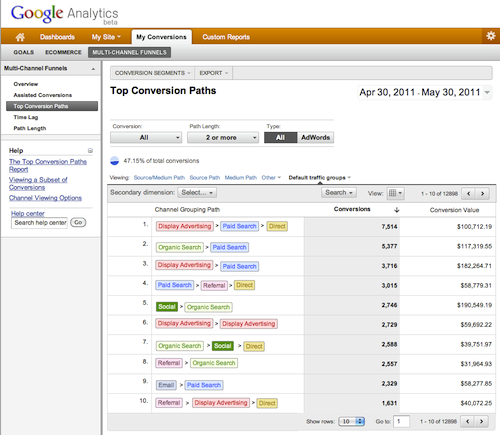Google Analytics just keeps getting better and better as far as I’m concerned and marketers that use this free tool need to get better and better at understanding what it can tell you.
On a side note, anytime Google improves a free tool they are probably getting ready to offer a paid version. Quite frankly the tool is worth paying for if you take advantage of the many ways to slice and dice your data.

You have to move beyond tracking site and page visits and get to the data that can actually help you make better marketing decisions.
On top of learning how to improve your conversions, when you understand the meaning behind your marketing data, you can gain a far greater understanding of everything about your business.
Google Analytics has steadily added more features that can help you create and track conversion goals and paths to conversion on your site. They’ve added real-time, social and mobile data reports so you can analyze traffic and conversion from just about every dimension. (Keep up with Analytics blog)
Below are five somewhat new functions that I think are worth taking the time to understand.
1) Multi-Channel Funnels
Multi-Channel Funnel Reports are a great way to get a handle on how your entire inbound marketing effort is doing. Once set up these reports tell you what channels customers interacted with during the 30 days before conversion or purchase.
This can effectively allow you to see a complete picture of the steps your customers take before purchasing or converting. This way you can identify time lags and friction as well as identify your most effective channels.
This is also a great way to better understand the value of social media, for example, as you can view how Twitter may have assisted in the path to conversion, even if it started with a Google Ad.
Here’s a nice tutorial on Multi Channel Funnel set-up.
2) Mobile Stats
I’ve been pushing for mobile themes and flexible design for some time now and my view is the tremendous growth in smaller tablets is going to push this beyond mandatory.
My site currently receives about 12% of its visits via mobile devices, including iPads. This is up 30% over comparison to just April of this year.
Google Analytics has a mobile tab and you must start paying attention to current state and growth state of mobile on your site as you determine what mobile-based enhancements you make to your site and marketing in general.
One tip for watching growth: You can compare one date range to another by dropping down the date range function in the upper right corner and clicking the compare box.
3) Search Engine Optimization
Another potentially valuable report is the Search Engine Optimization Report found in your Traffic Sources tab. You’ll need to integrate your Google Webmaster Tools account with Google Analytics to access this. If you have a Webmaster account Google will ask you to allow access, if you don’t you’ll need to set one up, which you certainly should for a variety of other reasons.
This report gives you some insight into how well your site is ranking for specific keyword phrases. It shows you the search volume for the term, how much traffic you are receiving, the impressions and the average position you hold for the term.
My experience is this is a bit wonky as it averages many things, but it’s not a bad way to find terms that you might want to work a little harder at optimizing your site for. This also a great place to do some comparison date ranges to see the impact of your SEO tweaks.
4) Social Conversion Goals
Not too long ago Google integrated social tracking into the Analytics suite to provide a fuller range of information regarding social network activity.
In addition to tracking how much traffic you are receiving from the various networks, you can build conversion goals for each network and see, for example, how many Twitter visitors sign up for your newsletter.
Out of the box Google tracks any +1 activity to and from your site, but if you want to add other plugins, such as Likes and InShares, you’ll need to do a little work to get these tracked properly. Here’s the tutorial on setting up Google Analytics with Social Plugins.
5) Real-Time Visits
The last report to cover today is Real-Time. This is accessed through the Home tab and Real-Time tab. This report, as the name suggests, shows you what is going on in real-time. Data from most reports in Google Analytics lags a day or more behind.
You can see how many visitors are currently on your site, top social sources, top active pages and top referral sources.
This data can be a bit distracting if you become obsessed with watching it, but the real reason I like it is that if I check it a couple times a day and I identify when a high traffic or profile site has linked to one of my blog posts and perhaps jump on over and add some comments while the conversation is fresh.
It’s also a nice way to monitor the impact of a campaign or even email newsletter click through in real time.
There’s much to learn in this category and, while it can sometimes feel like Calculus, it’s where the really smart marketers go to get better at their craft. I’m a big fan of the books by Avinash Kaushik and you may also want to grab this eBook – Google Analytics Integrations.

